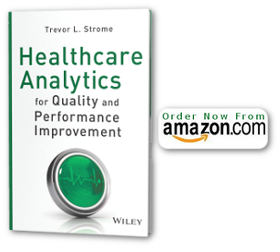Strategic Growth versus Growth by Aggregation
I used to say that business intelligence and analytic portals would grow by “aggregation”. That is, the number of reports, dashboards, and other analytic tools within a portal would grow based on the number and type of ad-hoc requests received by the developers. Once an ad-hoc request was completed for a particular end-user, it would be “genericized” and then added to the portal so that others with similar requests would be able to pull the data on their own.
A pressing problem for smaller healthcare business intelligence and analytic shops is that they can become inundated with many data requests. These shops become too busy “revolving” (that is, dealing with an ever growing number of information and development requests) to be “evolving” the portal (enhancing/organizing the existing analytic infrastructure and developing new tools of tactical and strategic significance).
A former Air Force commander of mine always said to me that if you’re too busy fighting off aligators, you’ll never be able to drain the swamp. Meeting the day-to-day information requirements of busy healthcare executives, managers, or process improvement facilitators (while VERY important) can likewise seriously hinder getting the “big picture” important work done. The irony of this situation is that much of the work that gets deferred due to “revolving” actually would likely enable end-users to get the actual information they’re looking for on their own in the first place!
Leveraging Requests to Strategic Advantage
Of course, the day-to-day requests are never going to go away. As the business intelligence and analytics tools evolve and users’ sophistication increases, end-users of healthcare analytics will challenge the capabilities of analytics portals by identifying new and creative requirements, or finding new questions to answer. But this is good news! When I used to develop software, I found that the end-user was always the best sources of ideas for software upgrades and/or new features, and the same goes for development of analytics tools. The key is to leverage the requests and insights of end-users so they help drive your analytics system forward in its evolution. This can be like harnessing the power of a tsunami, but it is possible, and absolutely necessary!
Three Steps to Harnessing the Tsunami!
Nothing can replace an effective Project Management methodology to improve the efficiency with which development tasks are undertaken. But, if you need to gain control quickly, here are some basic steps that will help bring order back to your analytics development.
1. Set Expectations (of yourself and end-users). Most people don’t know how much work it can take to develop new analytic tools, or build complex new reports, from scratch. Develop a Service Level Agreement (SLA) that states to your customers what they should expect in terms of turn-around times. It doesn’t need to be comprehensive. Simply set a delivery baseline based on the size of your shop, complexity of data, typical sophistication of requests, and usual turn-around time on requets.
2. Categorize Requests. Some requests will be one-off (i.e., throw-away), and others will help build toward strategic evolution of your analytics capabilities. Recognize the one-offs, and don’t try to shoe-horn them into the portal. As well, don’t upset your portal structure to accommodate one-offs that don’t contribute to strategic direction. Process the one-offs efficiently to get them off your development plate, so the team can focus on the strategic goals.
3. Time-box development. Ensure that all development follows a schedule. Without effective scheduling or project management, it is too easy to become inundated with development work and to become indiscriminate about the direction that analytics development is going. Make sure that time an appropriate amount of dedicated time is set aside to achieve strategic development goals.
In Summary…
By simply adding a few filters to the incoming rush of requests, it is possible not only to deal more effectively with the volume of requests for information, but to leverage such requests in such a way that actually help you achieve the strategic development goals of your healthcare analytics portal.

{ 0 comments… add one now }